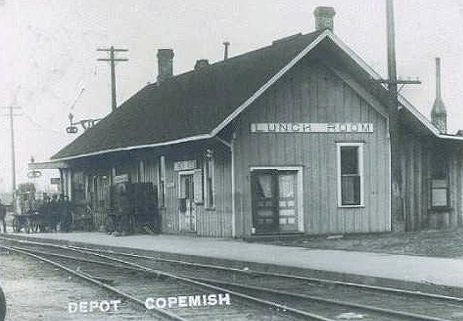- Details
- Hits: 5331
Station: Copemish, MI






 Copemish was settled about 1883 by the Buckley Douglas Lumber Co. as a campsite. It was a railroad junction point in northeast Manistee County, being served by the Ann Arbor Railroad, the Manistee & Northeastern, and the Arcadia & Betsey River railroads. It became a village in 1891.
Copemish was settled about 1883 by the Buckley Douglas Lumber Co. as a campsite. It was a railroad junction point in northeast Manistee County, being served by the Ann Arbor Railroad, the Manistee & Northeastern, and the Arcadia & Betsey River railroads. It became a village in 1891.
Notes
According to the [DFP], the name Copemish is from an Ottawa word meaning beech, or beech tree ground, and was given it by Harry W. Ashley of the Ann Arbor railroad.
Comment from Jim Rafferty: In light of the position of the two train order signals in the top photo and the known angle of the crossing of the AA and M&NE railroads, I think it is almost certain that the station was used as a 'Union" station, by both roads.
Photo Info: Top, the Copemish depot, including its "lunch room" to feed the passengers on early trains. 2nd to 4th photos, more views of the depot at Copemish union depot. [David McNeill collection]. 5th and 6th photos, these are reported to be the former Copemish station which is now a private residence in Glen Arbor. Taken in 2005. [Alan Loftis]. 7th photo, a map of Copemish with railroads shown.
Time Line
1889. The town is situated on Bear Creek, Cleon township, Manistee county, and is in the midst of a dense hardwood country. A large proportion of the timber is beech, hence the name. The site has been platted by the two railroads and lots are on the market and already buildings are being erected in every direction. The Copemish House, a large hotel, will be ready for the guests in a few days. [OT-1899-1025[
1890. The Detroit Free Press reported that Copemish was the liveliest, if not the largest city on the line of the Toledo, Ann Arbor & Northern railroad. It was platted three months ago by Ed Buckley, or Buckley & Douglas, owners of the Manistee & Northeastern railroad. The Name Copemish, from an Ottawa work meaning beech, or beech tree ground, was given it by Harry W. Ashley, General Manager of the TAA&N railroad. The town was reported as being forty miles from Cadillac and "in the opinion of railroad men" bound to be the great railroad center of that section of the Lower Peninsula. [DFP-1890-0104]
The same article described "riding the railroad line from Cadillac to Copemish on the engine which drew the passenger train was an experience out of the usual order.
"The tall, dense timber on either side of the track occasionally changed from evergreen pine to the deciduous hardwood, now leafless and sturdy in appearance. Everywhere the shadows were heavy, and though no underbrush cumbered the woods the trees stood so close together than eyesight failed to penetrate more than a short distance.
"The snow-fall, sheltered by the adjacent timber, marked a straight line upon one side of the track, extending far into the distance and cut off by somber trees marking a turn in the road.
"From lonely log houses near the track women and children came out to see the passing train. They hailed it with waving handkerchiefs. It cheers them in its daily passage, and they welcome it as the only event that varies the monotony of a settler's life in the wilderness. [DFT-1890-0104]
January 5, 1898. An expensive railroad smashup occurred here this morning just at daylight. The M&NE log train had just stopped at the tank to take water, the engine standing midway across the diamond of the Ann Arbor track, when about a dozen loaded freight cars with the caboose ahead from an Ann Arbor through freight that had been going up-grade four miles east, came tearing back here at fifty miles an hour, the caboose striking the M&NE freight engine square in the middle, knocking it a distance of forty feet into a ditch. The engineer and firemen escaped with severe but not serious bruises. The force of the cars colliding at such speed drove the caboose about ten rods down the track and left it a mass of kindling wood and old iron. Three car loads of flour next to the caboose met a like fate. The conductor on the freight train is said to have been asleep in the caboose, or the accident might have been prevented. He crawled out and has a few scratches. [DFP-1898-0106]
1900. This is a telegraph station on the Ann Arbor railroad. [OG-1900]
1909. The two railroads here had a joint water tower, with access by either road.
1915. ICC valuation says that the crossing is protected by a movable gate. Maintenance cost is 50% for each railroad.
Industry
- Buckley & Douglas Lumber Co. large general store
- Chapman-Sargent Co.
- Copemish Rolling Process flouring mill
- Franz Krein factory - wood slats. hamstocks and single trees.
- Manistee hoop works.
- Nixdorff Koen Manufacturing Co.
- Steffens Bros. planing mill
Bibliography
The following sources are utilized in this website. [SOURCE-YEAR-MMDD-PG]:
- [AAB| = All Aboard!, by Willis Dunbar, Eerdmans Publishing, Grand Rapids ©1969.
- [AAN] = Alpena Argus newspaper.
- [AARQJ] = American Association of Railroads Quiz Jr. pamphlet. © 1956
- [AATHA] = Ann Arbor Railroad Technical and Historical Association newsletter "The Double A"
- [AB] = Information provided at Michigan History Conference from Andrew Bailey, Port Huron, MI

